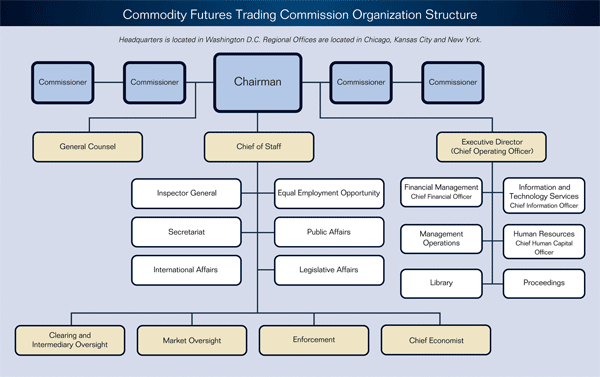Commission at a Glance: Mission Statement, Commodity Futures Industry, & CFTC Organization
Table Of Contents
Mission Statement
The mission of the CFTC is to protect market users and the public from fraud, manipulation, and abusive practices related to the sale of commodity futures and options, and to foster open, competitive, and financially sound commodity futures and option markets.
Commodity Futures Industry
Futures contracts on agricultural commodities have been traded in the United States for more than 150 years, and have been under Federal regulation since the 1920s. At the time the Commission was established in 1974, the vast majority of futures trading took place on commodities in the agricultural sector. These contracts gave farmers, ranchers, distributors, and end users of everything from corn to cattle, an efficient and effective set of tools to hedge against price movements.
Over the years, the futures industry has become increasingly diversified. While farmers and ranchers continue to use the futures markets actively to lock in prices for their crops and livestock, highly complex financial contracts based on interest rates, foreign currencies, Treasury bonds, securities indexes, and other products have far exceeded agricultural contracts in trading volume. The latest statistics show that approximately eight percent of on-exchange commodity futures and option trading activity occurs in the agricultural sector, while financial commodity futures and option contracts make up approximately 79 percent of trading activity, and other contracts, such as those on metals and energy products, make up about 13 percent.
The increase in trading activity, number of participants, and complexity and number of contracts available, has transformed the futures markets into a trillion dollar industry with massive economic force. In addition, the rapid evolution in trading technologies, cross-border activities, product innovation, and greater competition have made the futures markets an integral and significant part of the global economy.
Moreover, the electronic integration of cross-border markets and firms, as well as cross-border alliances, mergers, and other business activities continue to transform the futures markets and the firms involved in these markets into a global industry.
How the CFTC is Organized and Functions
The President appoints and the Senate confirms the CFTC Commissioners to serve staggered five-year terms. No more than three sitting Commissioners may be from the same political party. With the advice and consent of the Senate, the President designates one of the Commissioners to serve as Chairman.
The Office of the Chairman oversees the Commission’s principal divisions and offices that administer the policies, regulations, and guidance regarding the CEA, as amended. The Office of the Executive Director (OED), by delegation of the Chairman, directs the internal management of the Commission, ensuring that funds are responsibly accounted for and that program performance is measured and improved effectively.
Attorneys at the Commission work on complex and novel legal issues in areas such as litigation, regulation, and policy development. Among other things, they represent the Commission in administrative and civil proceedings; assist U.S. Attorneys in criminal proceedings involving futures law violations; develop regulations governing clearinghouses, exchanges, and intermediaries; provide a wide range of analysis, technical assistance, and guidance on regulatory, legislative, and supervisory issues; and provide legal advice to the Commission on policy and adjudicatory matters. In response to the globalization of the futures markets, attorneys represent the CFTC internationally in multilateral regulatory organizations, bilaterally with individual foreign regulators, and participate in country dialogues organized by the U.S. Department of the Treasury (Treasury).
Auditors, risk analysts, and attorneys examine records and operations of futures exchanges, clearinghouses, and firms for compliance with the provisions of the CEA and the Commission’s regulations, while futures trading investigators and specialists perform regulatory and compliance oversight to detect potential fraud, market manipulations, and trade practice violations. Risk analysts also perform analyses, which includes stress testing, to evaluate financial risk at the trader, firm, and clearinghouse levels.
Economists monitor trading activity and price relationships in futures markets to detect and deter price manipulation and other potential market disruptions and they monitor compliance with speculative position limits. Economists evaluate filings for new futures and option contracts and amendments to existing contracts to ensure they meet the Commission’s regulatory standards. Economists also analyze the economic effect of various Commission and industry actions and events, and advise the Commission accordingly.
The CFTC is headquartered in Washington, D.C. Regional offices are located in Chicago, Kansas City, and New York.
Additional information about the Commission and its history can be obtained from the Commission’s Office of Public Affairs or through its Web site, http://www.cftc.gov.
Organization and Locations
< Previous Page | Table Of Contents | Next Page >




 D
D